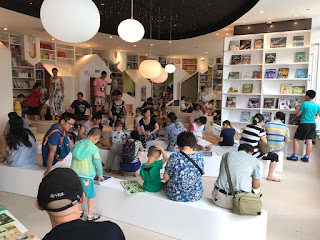-- Two new subways, Line 2 and Line 4, adding to the solitary Line 1 from 2012 (with as many as five more lines on the way!).
-- A new light rail line running from the Suzhou New District (SND) to Taihu Lake.
-- A canal-side park with walking paths that encircles the entire city, on either side of the moat.
-- A new Grand Canal Museum near the Wannian Bridge (across from Xumen Gate).
-- A new Museum of Education, occupying the grounds of the Chai Garden.
-- Ke Yuan garden open to the public, opposite the Canglangting (Surging Waves) garden.
-- Multiple, and occasionally massive, new shopping malls and plazas in the SND and SIP.
-- Completion of the Dongfang Zhimen (Gateway to the East) building at Jinji Lake.
-- Countless new restaurants and an increasingly internationalized range of dining options.
And, thanks to a city-sponsored campaign to encourage more book reading, multiple new bookstores and cafe / bookshops, including the cavernous, Taiwan-based Eslite and the multi-level Zizai (Xinhua) Bookstore in the SIP's Phoenix Mall. As wonderful and welcoming as these bookstores are, nothing prepared me for the architectural extravagance and sheer uniqueness of Zhongshuge.
What appears from its entrance area (above) as a modern but not particularly unusual bookstore quickly gives way inside to an entirely different sort of book-selling space. First, there are the tentacular light curtains, the room darkened, the string lights continuously shifting color:
That unusual transitional area hardly prepares the visitor for what lies just ahead, a long, expansive, and decidedly lively space that practically pulsates with decorative shapes and colors. As if to remind shoppers that there are books to be browsed and bought, Zhongshuge provides a profusion of opportunities to sit and turn pages, from a coffee and tea area to chairs to multi-step floor seating areas.
A semi-enclosed children's area toward the back of the store offers a playfully inviting but (thankfully) rather less visually distracting place for parents to introduce their youngsters to the world of books and reading.
The store's proprietors have christened the four main sections of the store with fanciful names: "Sanctuary of Crystal" for the entry area, "Cave of Fireflies" for the room of recommended books and dangling light strings, "Xanadu of Rainbows" for the main book room, and "Palace of Innocence" for the children's books.
Zhongshuge opened in Suzhou on July 13, 2017. The store is located at Su Yue Square, 119 Suzhou Avenue in the Xinghai Square area of the Suzhou Industrial Park (SIP). Interestingly, this is the eighth Zhongshuge bookstore in China. Other locations include Beijing, Hangzhou, Chengdu, Yangzhou, Songjiang, and Shanghai, and each has its own visually distinctive interior design.
First-time visitors to Zhongshuge cannot help but pull out their smartphones and start taking pictures. The store's interior design is so unusual, so eye-catching, one almost forgets that books are displayed there for purchase. Hopefully, Zhongshuge's decor will bring in paying customers and not just gawkers.




















































